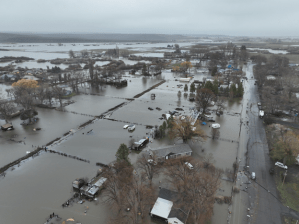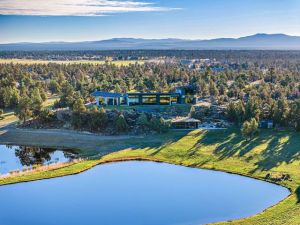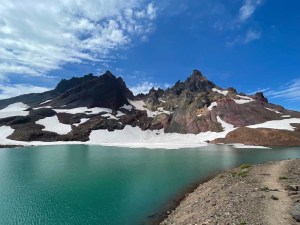Deadly float at Dillon Falls raises safety questions
Published 5:44 am Wednesday, August 6, 2025
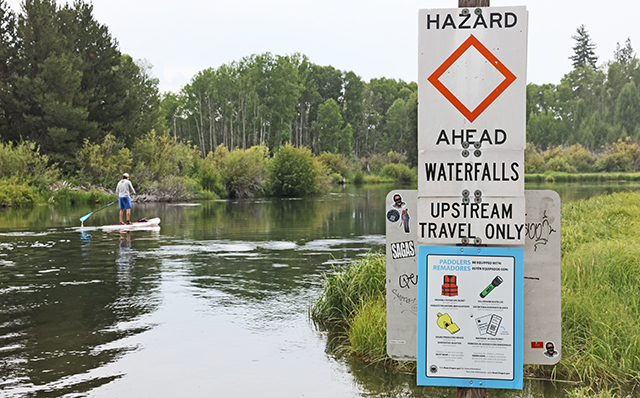
- A paddler travels upstream from the boat ramp above Dillon Falls on the Deschutes river. 08/01/25 (Dean Guernsey/The Bulletin)
Officials weigh safety measures but say human choices remain the biggest factor
On a sweltering day in mid-July, a group of six tourists tied their inner tubes together and hopped into the Deschutes River upstream of Dillon Falls, about 10 miles west of Bend. After lazily floating along a calm stretch of the river, they passed the final turnout to safety and, unknowingly, were headed for the dangerous falls.
Moments later, the river picked up speed. Around the bend it was clear danger was approaching. The group abandoned their tubes and started a desperate swim for shore.
Jason Carr, a spokesperson with the Deschutes County Sheriff’s Office, said in the moments to follow, three of the floaters were in a spot in the river closer the shore where they were swept into an eddy (a circular flow of current that churns away from the downstream flow). That positioning allowed them to swim to the bank and exit the river — and saved their lives.
Extreme descent
Trending
The remaining three floaters — one man and two women — were pulled into the fast-moving downstream current, away from their companions in the eddy. There are several cascades and rapids in this stretch of river for around one third of a mile. Near the top of the section is a 15-foot waterfall. It is considered an extreme descent even for experienced kayakers.
None of the three floaters swept downstream survived the decent through the rapids. The victims of the July 19 tragedy at Dillon Falls include Amanda Loyd, 40, of Rockwall, Texas and Lindsay Bashan, 33, of Parkland, Florida. The name of the third person, a man, hasn’t been released.
The bodies of Loyd and Bashan were found floating toward the bottom of the rapids, said Carr. The body of the male victim has not been located but based on work by cadaver-sniffing dogs, it is most likely still somewhere near the beginning of Dillon Falls. As of Tuesday, search and rescue teams were still looking for the body.
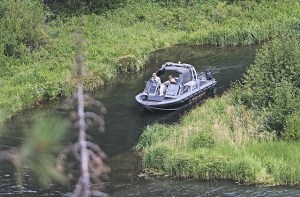
Deschutes County Sheriff’s Department personnel continues the search for a missing person below Dillon Falls on the Deschutes river on Friday. (Dean Guernsey/The Bulletin)
Similar recovery efforts in the past have taken significant time to conclude. In 2021, the body of Alex Kollar was discovered two months after he drowned while kayaking just a short ways downstream, near Lava Island Falls.
Lingering questions
An investigation into how this incident occurred, conducted by the Deschutes County Sheriff’s Office, is ongoing and many questions linger about why the group didn’t exit the river at the takeout point. Signs are posted along the shore warning of the danger ahead, advising floaters of the final takeout.
“It’s still unknown exactly why they missed it,” said Carr. “For some reason they didn’t see it and I think the biggest reason is they are all from out of the area and were unlikely familiar with the river and probably didn’t anticipate the danger that was ahead.”
Trending
Other potential factors, such as impairment, remain unknown. Carr did confirm that the group wasn’t wearing lifejackets. Detectives investigating the incident have declined to speak directly with The Bulletin.
News of the incident has sparked widespread commentary on social media about ways to prevent such an incident from occurring again, especially since this was the third deadly incident at Dillon Falls in the past seven years. Maximillian Zalaya, 41, drowned here in 2022. Ronald Stevens, 84, also drowned in the waterfall in 2018.
More protections?
Some have wondered if a safety device such as a net or cable should be placed in the river above the falls. More signs have also been mentioned.
Jaimie Olle, a spokesperson with the Deschutes National Forest, which has jurisdiction over the area, told The Bulletin in an email that the Forest Service has focused efforts on preventing accidents by posting signs at several points along the river “with an emphasis on Know Before You Go.”
“We encourage the public to understand the stretch of the river they plan to recreate on in advance, have deliberate discussions about how to safely exit the river and ensure that everyone has the proper protective equipment for the activity they are engaging in,” Olle said.
Options evaluated
Olle says different options have been evaluated to keep boaters and floaters safe, although it has not found a way to “engineer a permanent solution” that does not end up creating more safety issues for all users.
“For example, a permanent line or net across the river would pose additional safety risks because the water level fluctuates depending on the runoff and the time of year,” said Olle.
“Additionally, there are some skilled kayakers who enjoy this stretch of water and we want to ensure that this access remains available and unimpeded for them so we do not inadvertently create safety issues for those users as well.”
Courtney Braun, the owner of Wanderlust Tours, a local operator that runs paddling trips in the Upper Deschutes, says she has not heard of any rope or cable in the river in the past (despite some reports that one once existed) but says she would be open to learning more about such a solution.
“While it seems like a good idea initially, I wonder if there are impacts to wildlife. What happens to wood and debris heading down river. How would that affect the whitewater paddling community,” said Braun.
Braun believes one low-cost option could be installing a loaner lifejacket box in areas where people get into the river, similar to the one at the Bend Whitewater Park near the Old Mill District in Bend.
More signs?
As for signs, the Forest Service won’t install any more than what is already on the banks of the river above the falls.
“Signage is already posted both at kiosks and along the riverbank leading up to the falls and take-out point. The Forest does not have plans to install additional signage,” said Olle.
However, Carr from the sheriff’s office says there could be opportunities for signs in the river itself, noting that in the past there have been “floating signs” in the Deschutes before the Colorado Avenue Bridge in the Old Mill area. Floating signs anchored to the bottom of the river past the Dillon Falls Day Use area could be considered, he said.
“We would support any enhancement in signage if that would help (but) you still can’t control, no matter how much signage or how big they are, human behavior and human choices. Sometimes those are factors that are uncontrollable,” he said.
Braun is of the opinion that more signs could help river goers who are new to the area.
“People can be lured into a false sense of complacency when they see other users paddling and the beautiful, flat and calm water,” said Braun. “For these paddlers, I do believe that a bit more signage with additional information about this popular stretch of river near both Dillon Falls boat ramp and Slough boat ramp would be super helpful.”
She adds that every river user needs to know the hazards and dangers of a river before the get into the water but says there are ways local agencies can help guide them.
“Extra information that is easy to consume is never a bad idea,” she said.
Carr adds that messaging to the public about safety on the rivers is also important. He encourages visitors to take safety precautions (including wearing lifejackets), avoid intoxicants and research the river ahead of time.
“Know what you’re getting yourself into first and foremost, especially on rivers,” said Carr. “As calm as they may seem in one section, it can quickly turn into Class 5 rapids, such as Dillon Falls. That is the number one thing we stress — know where to get in, and know how to get out ahead of time. And all that information is out there.”




